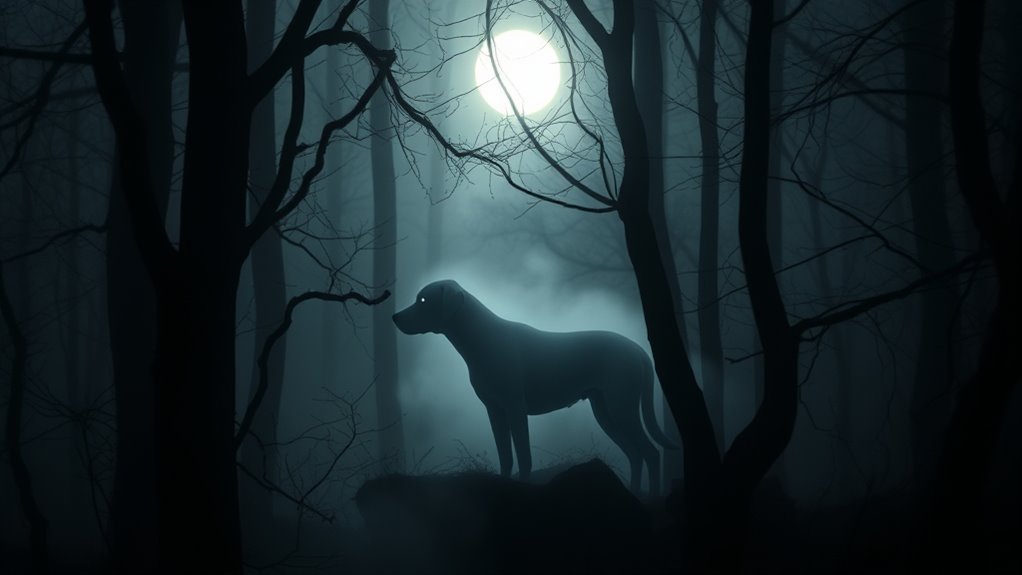Many cultures and personal experiences suggest that animals can become spirits or ghosts after death, often seen as protectors, messengers, or emotional remnants. Signs include fleeting apparitions, strange noises, or pets acting unusual, which some interpret as signs of lingering spirits. Scientific explanations point to natural causes and perception errors, but beliefs persist across traditions. If you’re curious about how these phenomena fit into cultural beliefs or scientific ideas, there’s more to explore below.
Key Takeaways
- Many cultures believe animals can become spirits or ghosts, often returning as guardians or messengers after death.
- Animal ghosts are usually perceived subtly through instincts, noises, or fleeting appearances, unlike vivid human ghost sightings.
- Natural explanations like environmental sounds, shadows, or psychological factors often account for perceived animal ghost encounters.
- Strong emotional bonds or unresolved feelings can cause animals to linger as spirits, especially if their death was traumatic.
- Cultural and spiritual beliefs typically view animal spirits as protectors or guides, not restless ghosts seeking resolution.
Historical and Cultural Perspectives on Animal Spirits
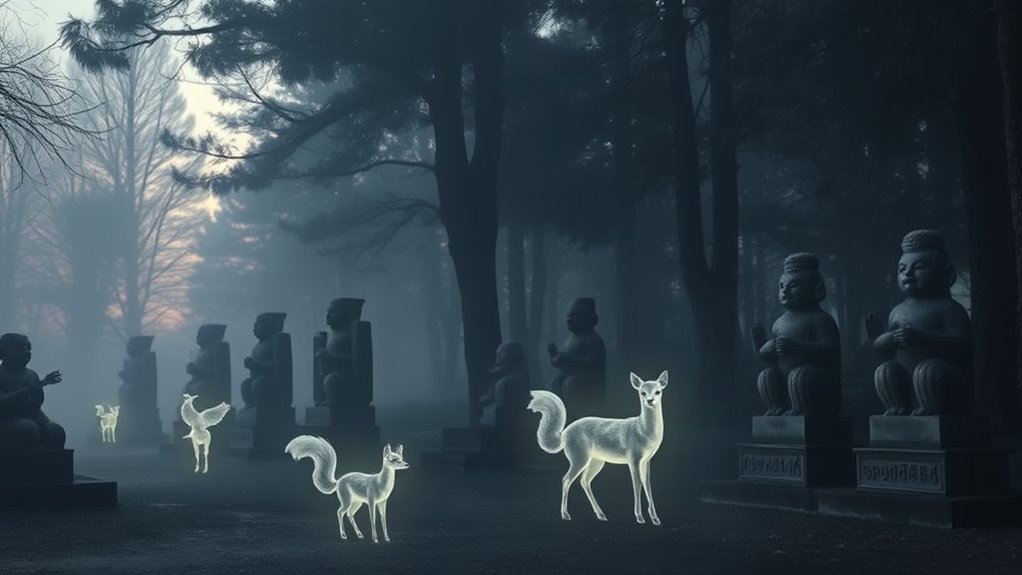
Throughout history and across cultures, animals have often been seen as more than just creatures of the natural world; they’ve been regarded as spiritual messengers or symbols of divine presence. Many societies believe animals carry messages from spirits or ancestors, serving as guides or protectors. In ancient Egypt, cats symbolized mystery and protection, while in Native American traditions, animals like the wolf or eagle represented strength and spiritual insight. Similarly, in Asian cultures, dragons and koi fish embody wisdom and transformation. These beliefs reflect a deep connection between humans and animals, viewing them as intermediaries between the physical and spiritual realms. This perspective fosters the idea that animals might transcend their earthly existence, potentially returning as spirits or ghosts to fulfill ongoing spiritual roles. Animal spirits are often considered to serve as ongoing guardians or messengers from the spiritual world, reinforcing the idea that animals can become ghosts or spirits after death.
Common Signs and Encounters Reported by Pet Owners

Many pet owners report experiencing strange and compelling signs that suggest their animals are trying to communicate from beyond the physical world. You might notice your pet staring intently at empty spaces or reacting to unseen movements, which can feel eerie. Some owners hear faint noises, like pawprints or scratching sounds, even when their pet isn’t nearby. Others report their animals appearing restless or suddenly behaving differently—perhaps pawing at corners, whimpering, or staring at nothing. You might also find your pet reacting to a presence you can’t see, such as suddenly sitting still or following something invisible. These encounters often evoke a mix of comfort and unease, making you wonder if your pet is sensing something beyond our reality. Understanding animal behavior can help interpret these mysterious signs.
Differences Between Animal Spirits and Human Ghosts
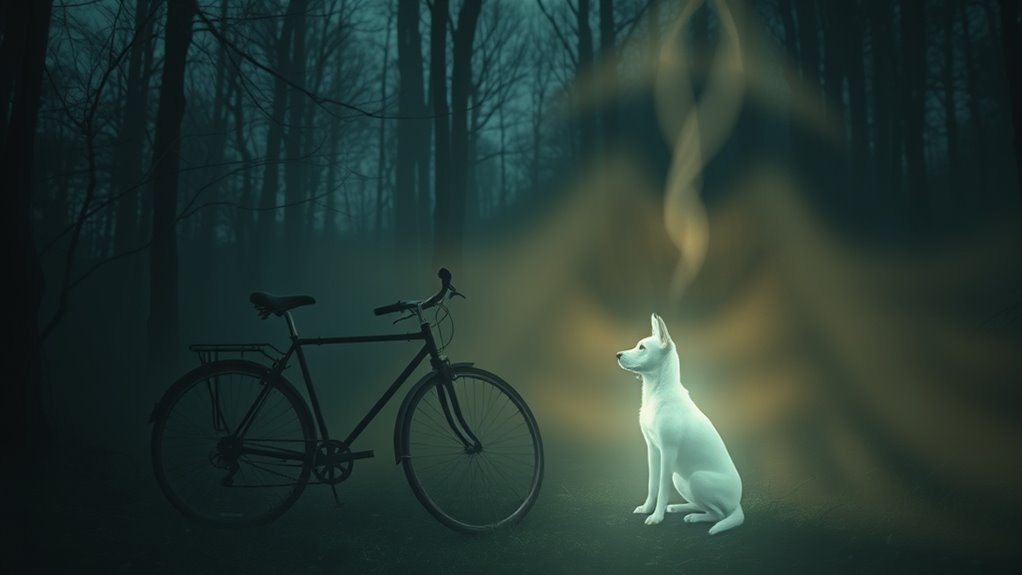
You might notice that animal spirits often appear differently than human ghosts, with distinct manifestations or behaviors. Your emotional attachments can influence how you interpret these encounters, making some seem more personal or comforting. Cultural beliefs also shape how societies perceive and explain these spirits, highlighting important differences between animal and human apparitions.
Spirit Manifestation Differences
Animal spirits and human ghosts often differ in how they manifest and are perceived. Animal spirits tend to appear more subtly, often through fleeting glimpses, strange noises, or feelings rather than clear, detailed visions. They may manifest as gentle presences or instinctual impressions, like sensing an animal’s presence nearby. Human ghosts, on the other hand, often appear more vividly, sometimes with recognizable features or through visual apparitions. Their manifestations can include full-body apparitions, voices, or physical disturbances. You might notice that animal spirits communicate through emotions or instincts, while human ghosts often try to relay messages or seek closure. These differences shape how you interpret their appearances and influence your understanding of their presence. Recognizing these distinctions helps you distinguish between animal spirits and human ghosts during encounters. Additionally, understanding manifestation styles can aid in identifying the true nature of these supernatural presences.
Emotional Attachments Influence
Emotional attachments play a significant role in how spirits manifest and the nature of their presence. When you’re deeply connected to an animal or person, your feelings can influence the spirit’s behavior and appearance. Animal spirits often linger because of strong bonds, like a pet’s loyalty or love. These attachments can cause the spirit to appear more active or visible. Unlike human ghosts, animal spirits tend to focus on comfort, protection, or companionship rooted in emotion. Your emotional ties can also determine whether the spirit remains nearby or moves on. Understanding these bonds helps explain why some spirits are more persistent or visible. Additionally, the vibrational energy associated with strong emotional connections can affect spiritual manifestation and influence how spirits choose to interact with the living.
Cultural Interpretations Variations
Cultural beliefs shape how societies interpret animal spirits differently from human ghosts. In many cultures, animals are viewed as messengers or protectors, symbolizing qualities like loyalty, wisdom, or guidance. For example, in Native American traditions, certain animals represent spiritual guides that assist humans in their journeys. Conversely, human ghosts are often seen as restless spirits or ancestors seeking closure. Some cultures believe animal spirits serve as intermediaries between the living and the spiritual sphere , while human ghosts may embody unresolved emotions or guilt. These distinctions influence rituals, stories, and taboos surrounding spirits. You might find that in some societies, animals are revered or honored after death, whereas human ghosts are feared or memorialized. Understanding these cultural nuances helps clarify why perceptions vary so widely across different traditions.
The Role of Pets in Various Cultural Beliefs About the Afterlife
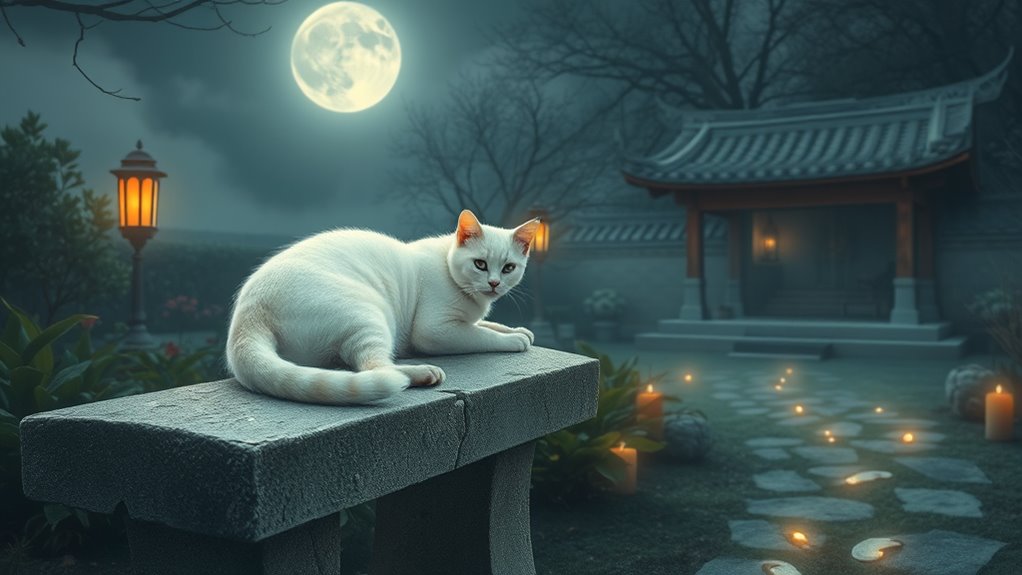
In many cultures, pets are believed to play important roles in the afterlife, either as part of ancestor worship or as spiritual guides. You might find that animals are honored to maintain connections with loved ones or to assist souls on their journey. Exploring these beliefs reveals how deeply animals are woven into spiritual traditions around the world. Understanding size restrictions for tiny houses can also be crucial for ensuring that pet habitats meet local regulations and are safe for animals.
Pets in Ancestor Worship
Many cultures believe that pets serve as essential companions in the afterlife, playing roles that go beyond their earthly presence. In ancestor worship, animals often symbolize loyalty, protection, and spiritual connection. They may be included in rituals to honor ancestors or act as guides for spirits. Some traditions see pets as messengers, carrying prayers or offerings to the spirit world. Others believe pets serve as guardians, ensuring the safety of the departed in their journey. These beliefs reflect a deep respect for animals’ spiritual significance and their ongoing bond with loved ones. Understanding these practices shows how animals are woven into the fabric of cultural afterlife beliefs, emphasizing their importance in maintaining familial and spiritual continuity. spiritual significance underscores how animals are revered for their roles in connecting the living and the dead.
Spirit Guides and Pets
Throughout various traditions, pets are believed to serve as more than just companions; they act as spiritual guides in the afterlife. People often see pets as messengers or protectors that help souls navigate the spiritual domain. In some cultures, pets are thought to accompany their owners beyond death, providing comfort and guidance as they transition to the next stage of existence. These animals are believed to carry the spirits of loved ones or serve as intermediaries between the living and the spiritual world. Their presence is considered a blessing, offering reassurance and companionship during the journey. Whether as guardians or guides, pets hold a sacred place in many beliefs about the afterlife, symbolizing loyalty, love, and spiritual connection even after death. Additionally, some traditions emphasize the significance of animal symbolism in understanding the spiritual journey and the enduring bond between humans and their pets.
Scientific Explanations for Animal Apparitions and Paranormal Activity
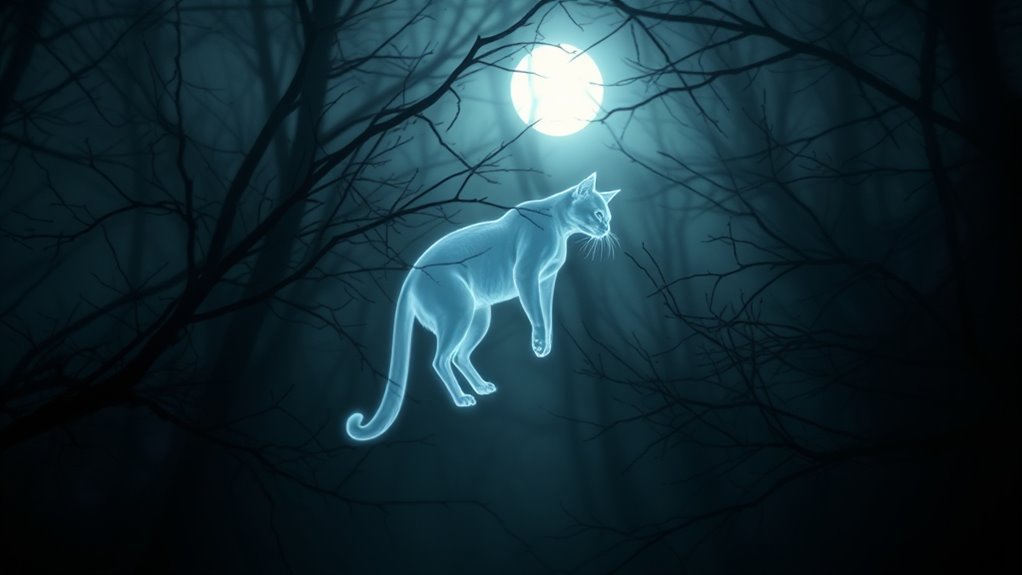
Scientific research offers several explanations for animal sightings that some interpret as ghosts or paranormal activity. These phenomena can often be attributed to natural causes or psychological factors rather than supernatural forces. You might experience a fleeting shadow or hear sounds that seem unusual but have logical origins. Vacuum cleaner performance metrics can sometimes be mistaken for unexplained noises, especially if the equipment is noisy or malfunctioning.
- Hearing or Seeing Misinterpretations: Our brains sometimes misinterpret familiar sounds or shapes, leading to the perception of animal ghosts.
- Environmental Factors: Low-frequency sounds or electromagnetic fields can create sensations or illusions of animal movements or presence.
- Psychological Triggers: Grief, fear, or heightened emotions can cause you to perceive animals where none exist, especially in states of distress or exhaustion.
Understanding these scientific explanations helps demystify many animal sightings, emphasizing natural causes over paranormal ones.
Famous Cases and Sightings of Ghostly Animals

Famous cases of ghostly animals have fascinated and puzzled people for generations, blending stories of the supernatural with moments of unexplained sightings. You might have heard about the ghostly black dog seen wandering deserted roads or the apparition of a beloved pet appearing after its death. One well-known story involves a ghostly cat that appears at a specific house, only to vanish when approached. Some witnesses claim to see glowing eyes in the darkness or hear faint meows and howls from unseen animals. These sightings often occur in places with emotional significance or tragic history. While skeptics dismiss them as illusions or memories, believers see these encounters as genuine ghostly manifestations. Such stories continue to fuel curiosity and debate about the mysterious afterlife of animals. Additionally, the cultural impact of these tales reflects society’s fascination with supernatural phenomena and the enduring bond humans share with their pets.
How to Differentiate Between Imagination and Actual Encounters

Distinguishing between genuine ghostly encounters and vivid imagination can be challenging, especially when emotions run high or the surroundings are dimly lit. To tell them apart, pay attention to your mental state and environment. Ask yourself if you’re feeling anxious or tired, which can trigger hallucinations. Consider if the “sighting” happens repeatedly or only once—ghostly visits tend to recur. Also, observe your surroundings: Are there natural explanations like shadows, creaky floors, or reflections? Keep these in mind:
- Check for consistent details in repeated sightings.
- Notice if others perceive the same phenomena.
- Reflect on your emotional and physical state at the time.
- Be aware that narcissistic behaviors such as projection or manipulation can distort perceptions, making it harder to discern reality from illusion.
Theories on Why Animals Might Remain as Ghosts
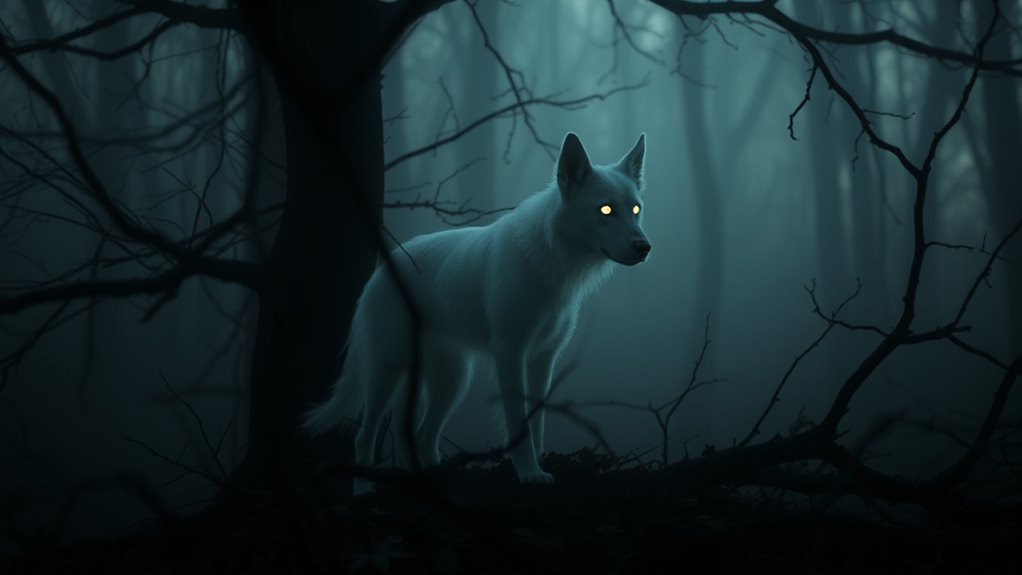
Many believe that animals, like humans, can linger as ghosts due to their strong emotional bonds or instinctual attachments. One theory suggests that animals, especially those deeply connected to their owners or familiar environments, may leave residual energies behind when they die. Their instinct to protect or remain close might cause their spirits to stay nearby. Some also propose that animals possess a heightened sensitivity to spiritual energies, making it easier for their spirits to persist. Others think that unresolved feelings, such as loss or trauma, could trap an animal’s spirit in a liminal space. These theories highlight the idea that emotional intensity and instinctual drives could influence an animal’s tendency to become a ghost, especially if their attachment to a place or person remains strong.
Ethical and Emotional Impacts of Believing in Animal Ghosts

Believing in animal ghosts can deeply affect how you process grief and attachment. It may offer comfort, helping you feel connected to a beloved pet after death. However, it can also complicate your emotional healing or lead to dependency on the idea of ghosts. Ethically, some worry that promoting belief in animal spirits might exploit grief-stricken individuals or reinforce unproven claims. You might find yourself questioning your perceptions or feeling guilty if you doubt these beliefs.
- Gain solace in the idea of ongoing connection, easing pain.
- Experience guilt or confusion when faced with skepticism.
- Influence how you mourn or remember your pet, for better or worse.
Exploring the Possibility: Do Animals Truly Become Ghosts?

The question of whether animals can truly become ghosts has fascinated humans for centuries, blending cultural beliefs, personal experiences, and scientific skepticism. You might have heard stories of pets appearing after death or feeling a presence that seems to be your lost animal. While these experiences feel real, science struggles to confirm them. Many experts argue that what you interpret as a ghost could be the mind’s response to grief, stress, or environmental factors. Others believe that animals lack the spiritual consciousness necessary for ghosts. Still, the idea persists in many cultures, fueling stories and legends. Ultimately, whether animals become ghosts remains unproven, but your personal experiences and beliefs shape how you interpret these mysterious occurrences.
Frequently Asked Questions
Can Animals Communicate From Beyond the Grave?
Yes, animals can communicate from beyond the grave, though it’s often open to interpretation. You might notice signs like strange noises, sudden appearances, or behaviors that seem out of place, which some believe are messages from departed pets. Keep an open mind and trust your intuition. While scientific proof is lacking, many find comfort in believing that their beloved animals continue to send signals from the other side.
Are Animal Ghosts More Common Than Human Spirits?
You might imagine animal ghosts as fleeting shadows dancing in moonlight, and yes, they seem more common than human spirits. Their presence feels like whispers on the wind, easy to notice in quiet moments. Animals often leave behind a trail of mysterious sightings, their spirits blending into our world. This frequent occurrence may be because they’re simpler beings, more open to the spirit domain, making their ghosts more visible and accessible to us.
How Do Animal Spirits Influence the Living World?
Animal spirits influence your world by offering comfort, guidance, and protection. You might feel their presence through subtle signs like sudden sightings, sounds, or changes in atmosphere. These spirits can help you navigate grief or remind you of loved pets who once brought joy. By paying attention and opening your mind, you can connect with their energy, feeling their influence shaping your experiences in meaningful, often comforting ways.
Is There Scientific Evidence Supporting Animal Ghost Sightings?
The scientific evidence supporting animal ghost sightings is like a faint whisper in a noisy room; it’s scarce and inconclusive. While many people report sightings or feelings, these experiences lack rigorous proof and often can be explained by psychological factors like hallucinations or misperceptions. You might believe in spirits, but science remains skeptical, requiring solid evidence before accepting that animals can truly become ghosts.
Can Animals Become Spirits of Different Species?
Animals can become spirits of different species, according to many spiritual beliefs and folklore. You might encounter stories where a pet’s spirit appears as a different animal, symbolizing transformation or a connection beyond physical form. While science doesn’t support this idea, many find comfort in the notion that spirits can cross species boundaries, serving as messengers or guides. Ultimately, it’s a matter of personal belief and spiritual perspective.
Conclusion
So, can animals become ghosts? Maybe it’s their spirit lingering, or perhaps our minds play tricks on us. Whether you believe in their afterlife or see it as imagination, one thing’s clear: the bond with your pet runs deep enough to make even the unseen feel real. In the end, isn’t it comforting to think that love’s energy can transcend even the bounds of life? After all, isn’t that what makes them truly unforgettable?
